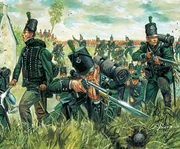
The 95th Rifles is one of two rifle regiments which fought for the British in the Napoleonic Wars; the other being the 60th Rifles. Note: For the purposes of Cornwell's stories, Richard Sharpe serves in the 95th, while William Frederickson serves with the 60th.
The Riflemen, nicknamed grasshoppers by the French, wore green jackets.They served during the Napoleonic Wars, from 1799 to 1815. The riflemen were trained to work in open order and to be able to think for themselves. They were to operate in pairs ahead of the main infantry as skirmishers. They were taught to make best use of natural cover and to harass the enemy with aimed shots. These tactics, which had originated in campaigns in North America, were unorthodox for the time. To aid speed and mobility, the Rifles used bugles to transmit commands rather than the drums used by Line infantry and for the same reason did not carry Colours.
The men and officers of the Rifles wore green uniforms rather than the usual red. Their belts and trim were black. The majority of officers of the 95th were commissioned or promoted based on merit or seniority. The Rifles were therefore known as a more egalitarian outfit than the redcoats.
The 95th Rifles went on to become famous for their actions during the Peninsular War, being awarded regimental battle honors for Ciudad Rodrigo, Salamanca, Vittoria, The Pyrenees, Toulouse, and Waterloo, among others.
The Rifle[]
The Baker rifle (officially known as the Infantry Rifle) was a flintlock rifle used by the Rifle regiments of the British Army during the Napoleonic Wars. It was the first standard-issue, British-made rifle accepted by the British armed forces. The Baker Rifle was first produced in 1800 by Ezekiel Baker, a master gunsmith from Whitechapel. The British Army was still issuing the Infantry Rifle in the 1830s.
Colonel Coote Manningham, responsible for establishing the Rifle Corps, influenced the initial designs of the Baker. Baker was provided with a German Jager rifle as an example of what was needed. The second model he made had a .75 calibre bore, the same calibre as the Infantry Musket. It had a 32-inch barrel, with eight rectangular rifling grooves; this model was accepted as the Infantry Rifle, but more changes were made until it was finally placed into production. The third and final model had the barrel shortened from 32 to 30 inches, and the calibre reduced to .653, which allowed the rifle to fire a .625 calibre carbine bullet, with a greased patch to grip the now-seven rectangular grooves in the barrel. The rifle had a simple folding backsight with the standard large lock mechanism, with a swan-neck cock as fitted to the 'Brown Bess.'
Like the German Jager rifles, it had a scrolled brass trigger guard to help ensure a firm grip and a raised cheek piece on the left-hand side of the butt. Like many rifles, it had a 'butt-trap' or patchbox where greased linen patches and tools could be stored. The lid of the patchbox was brass, and hinged at the rear so it could be flipped up.
The stocks were made of walnut and held the barrel with three flat captive wedges. The rifle also had a metal locking bar to accommodate a 24-inch sword bayonet, similar to that of the Jager rifle. The Baker was 45 inches from muzzle to butt, 12 inches shorter than the Infantry Musket, and weighed almost nine pounds.
Gunpowder fouling in the grooves made the weapon much slower to load and affected its accuracy, so a cleaning kit was stored in the patch box of the Baker.
